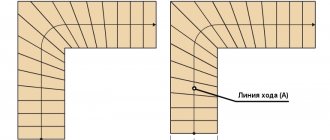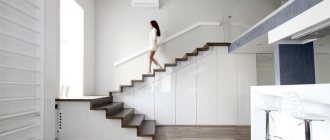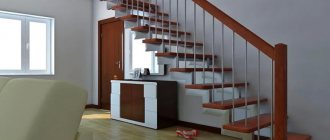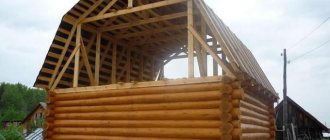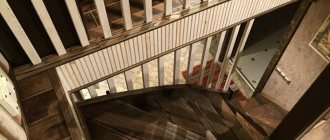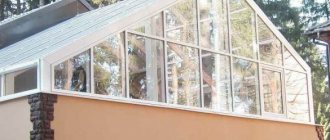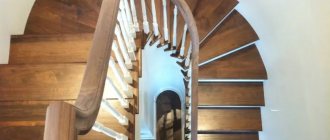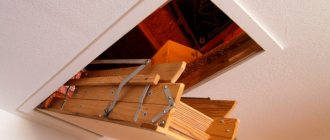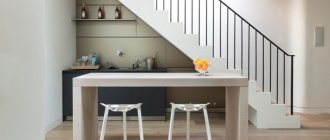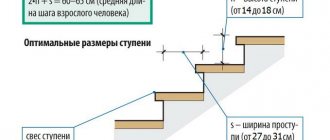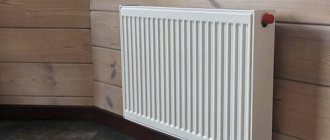Marching and spiral, straight and rotary, on a bowstring and stringer - all this is about internal stairs for a private home . The wide variety of designs is due to the development of technology and the huge number of situations where one or another system will be used most effectively.
To understand which staircase is more suitable for a particular situation, it is necessary to understand its advantages and disadvantages, and in order for the assessment to be objective, it is necessary to consider in general what structures are used to climb to the second floor.
In most cases, several main classifications are considered: by design, type of load-bearing element, material of manufacture, configuration.
- Stairs on bowstrings
- Staircases on stringers
- Stairs on rails
- Cantilever stairs
- Stairs on a support pillar
- Monolithic stairs
- Wooden stairs
- Metal stairs
- Concrete stairs
- Glass stairs
- Stairs are straight
- Winder stairs
- Goose ladders
Types of stairs by design
The first classifying characteristic of stairs for a private home is their design. It is selected taking into account not only the interior features of the room, personal preferences, but also the area available for use, the presence of limiting elements (windows/doors...).
Marching stairs
Flight stairs are structures that consist of one or more straight flights (spans), which are connected to each other by a platform or turning steps. This is the traditional and most common type of structure, which is found everywhere. They are practical, relatively easy to assemble and manufacture, reliable, and can withstand significant loads. They are distinguished by increased convenience, and subject to compliance with standards, ascent/descent is carried out at optimal angles of 30-45°.
In turn, marching stairs also have several classifications.
According to the march configuration:
- straight;
- rotary;
- L-shaped (with a rotation of 90°);
- U-shaped (with a rotation of 180°);
- T-shaped;
- S-shaped.
By type of intermediate element (interstrip connection):
- with an intermediate platform;
- with winder (rotary) steps.
Straight stairs are comfortable and safe to climb, but they also require a large free area, which is not always acceptable for small cottages.
Turning stairs are more compact, but also less comfortable to use. Moreover, these properties increase from L-shaped to U-shaped and from stairs with a platform to winders. Those. A U-shaped staircase with winder steps can “squeeze” the maximum out of the available space, with corresponding disadvantages for everyday use.
S- and T-shaped stairs are special cases and are extremely rarely used in private housing construction. In fact, all the rules of turning stairs apply to them.
Thus, if the layout and area of the room allows you to build a straight staircase, then it is better to choose it, because it provides comfortable movement for people of any age, which is a decisive factor when there are children and the elderly. In other cases, it is necessary to focus on the opening capabilities and the above notes.
Spiral staircases
Spiral staircases are the most ergonomic type of design with a radial arrangement of steps, which is mainly used when free space is as limited as possible. For most private houses, this is an extreme measure, since such structures are characterized by high production costs, are difficult to install, are quite dangerous and do not provide the necessary comfort when moving.
Depending on the shape of the horizontal projection, spiral staircases are conventionally divided into:
- spiral (circular);
- rectangular;
- patterns.
Spiral (circular/circular) stairs are classic screw structures with the same internal and external radius along the entire height.
Rectangular spiral staircases differ from the previous ones only in that the outer perimeter of the steps has the shape of a rectangle.
Patterned stairs are a type with variable inner and outer radii of the spiral.
Methods for obtaining a drawing
There are several ways to compile project documentation:
- On one's own. Many people can make calculations and draw a drawing of a staircase for simple structures (straight, rotary with a platform). More complex options are best left to professionals;
- Programs for designing stairs. They allow you to carry out detailed design, obtain visualization of the structure before installation and make adjustments. Using a 3D picture you can see how the staircase will fit into the surrounding interior. In this case, it may take several days to master the software;
- Ready-made solutions. Drawings of stairs presented on the Internet can be offered with or without detailed detailing. Such projects should be checked for compliance with calculations and building codes. You can contact professionals for advice.
Example of a finished drawing of a staircase
This will be much cheaper than making adjustments at the time of installation. Another subtlety - you should understand how the parameters of the ready-made solution will fit into the installation location; - Online calculators. Offered by some developers and manufacturers. Such software can calculate and automatically generate a drawing based on the entered data. The same programs display a list of recommendations for changing parameters if they do not meet technical standards. The disadvantage of calculators is that the design is not linked to the layout of a two-story house;
- Appeal to professionals. This method is considered the cheapest.
Because it is experience and professional skills that will allow you to perform competent calculations and drawings of the stairs, taking into account the features of the interior. The presented detailing and material recommendations can ensure the aesthetics, reliability, durability, comfort and safety of the finished structure.
Everyone chooses their own method of obtaining design documentation. If you have the strength and time, you can manually prepare a diagram and details of the staircase.
Stairs by type of load-bearing element
All types of stairs are complex functional structures with a powerful load-bearing frame, which ensures the integrity of the structure and withstands significant loads during operation. However, depending on the type of structure, the role of the basis of the supporting system can be performed by different load-bearing elements:
- bowstring;
- curved bowstring;
- kosour;
- broken stringer;
- straight monostring (mono-string);
- loaches;
- console;
- casing;
- monolith.
Stairs on a bowstring
A classic bowstring is an inclined wooden beam with specially prepared holes (grooves) on the inside for installing steps in a mortise manner. In general, a bowstring also refers to any straight inclined beam, i.e. The steps can be fastened not by cutting into the beam, but by using bars or corners. Stairs with this frame are highly durable and are the easiest to make with your own hands.
Curved String - A curved beam made of solid wood or plywood that is used as a frame for spiral staircases. It is highly complex to manufacture, but allows you to get rid of the support column in screw structures.
Stairs on a stringer
A stringer is a type of bowstring in which the beam has cuts for mounting steps on top. Thus, on one side the stringer looks like a broken line (zigzag), and the ends of the steps are also visible in the side projection. Staircases with a stringer are the most common, along with a bowstring, because they are characterized by minimal labor costs during assembly and allow for more efficient use of space (the stringer is included in the overall width of the staircase, and the stringer adds a few cm), however, other things being equal, they are less durable.
A broken stringer is a special case of a stringer, which is made of metal and has a zigzag shape on both sides. Withstands significant loads and can be used alone in the center of the flight.
Straight monostringer is almost the same as the previous option, only the supporting element is made of a straight profile pipe, which has special welded platforms for steps. There is no single accepted name for this strength element, so many also call this frame a monostring.
Stairs on rails
Bolts are a special type of fastening in which metal rods fasten steps together and connect them to the handrail, thereby turning the entire structure into an independent power frame. In this case, the role of the main load-bearing element is played by the wall or the stringer adjacent to the wall. The main criterion for choosing this frame is aesthetics.
Cantilever stairs
The console is a one-sided powerful support frame for attaching steps with fixation to the adjacent load-bearing wall. Most often, the power structure is hidden behind decorative trim to create the effect of “floating” steps and the absence of a frame. Stairs on such load-bearing elements do not have any advantages and are chosen solely from individual preferences.
Radial stairs
A casing pipe is a vertical support column made of a metal pipe, which allows the steps to be fastened in a through or adjacent manner. Used only when creating spiral (radial) staircases.
Monolithic stairs
The only type of self-supporting structures are reinforced concrete stairs. The role of the strength element here is played by the body itself made of concrete and reinforcement frame. Cast stairs do not require additional supports and support; with correct calculations, the structure has the highest strength. The main disadvantage is the significant weight and the need for a reinforced foundation.
Where to post: basic rules
Installing stairs to the second floor is a very individual process that depends on the size, layout and height of the ceilings in your room. The most popular place for stairs is still the hallway, especially in spacious detached houses. This way, when you enter your home, you have immediate access to all rooms without wandering down hallways.
The second most popular place to install an elevator is the living room. This is useful for medium-sized buildings if the ground floor leads to a separate room, such as a bedroom. In the hall connected to the kitchen, the staircase can be used for zoning.
Stairs by material
The third important classifying criterion is material . It largely depends on him:
- Appearance of the structure;
- Lifespan of the ladder.
Also, the material directly affects the combination of the structure with the overall interior of the room.
Wooden stairs
The traditional material for interior stairs is wood. Lumber is widespread, environmentally friendly and quite simple to work with, they can be easily processed, are easy to saw, sand, and have a high adhesion rate.
Coniferous and deciduous wood species are used for production, including: pine, spruce, larch, oak, ash, beech, birch and many others. Often materials are combined.
Each type has its own advantages and disadvantages, and the choice of breed is determined by the main criteria:
- price;
- durability;
- hardness;
- color and texture;
- hygroscopicity;
- susceptible to rotting.
If we consider the Russian market, then among the common types of wood, the highest quality, most durable, and, accordingly, expensive stairs are made of oak, and the most budget ones are made of pine.
It is worth noting that wooden structures have a huge palette of shades and retain their attractive appearance for a long time. At the same time, the design of the staircase can be refreshed at any time (by varnishing or painting). Also, the low density of wood (compared to metal and concrete) makes it possible to reduce the load on load-bearing floors.
Among the main disadvantages are the need for regular maintenance (impregnation treatment and restoration of the protective varnish layer), increased susceptibility of wood to pests, low fire resistance, and perhaps most importantly, gradual drying out and the appearance of squeaks.
Metal stairs
Let us immediately note that in the interior of private households, metal staircases almost always mean not the entire structure, but only the frame, since metal is a fairly cold and rough material, and it has to be sheathed, most often with the same wood.
For the production of elements, stainless steel, aluminum alloys, and cast iron are used. These materials are durable, high strength, can withstand significant loads, do not deform, are not afraid of temperature changes, are fireproof and do not cause squeaks.
According to the manufacturing method, metal stairs are almost always welded (forged ones are extremely expensive), which allows you to create structures with any configuration.
To the question: which staircase is better, wooden or metal, there is no definite answer . Each of them has its own advantages and disadvantages, and the manufacturing cost is approximately at the same level. You can build a cheap pine or metal staircase on simple steel profiles, or you can use expensive types of wood with carved trim or choose a forged staircase with artistic casting.
Concrete stairs
Concrete stairs are a monolithic structure made of concrete and reinforcement frame. In private houses, it is recommended to install only at the construction stage, since the frames of staircases and landings must be connected to each other to create a single system.
Distinctive features include:
- extremely high resistance to dynamic loads;
- variety of forms;
- labor-intensive manufacturing;
- heavy weight and increased requirements for the foundation.
The main disadvantage of concrete stairs is the need for cladding, which practically doubles the initial cost of the structure.
Glass stairs
The glass staircase is a modern design, which is made of multi-layer reinforced impact-resistant glass (triplex). As a rule, only steps and fences are made from triplex, and a different material is used for the load-bearing element. To prevent slipping, the surface of the tread is subjected to special treatment, after which the top layer of glass becomes matte.
Video description
About what kind of staircase to make in the house in the following video:
- Metal. Entirely metal (or metal frame) structures are reliable and durable. They look impressive and are appropriate in almost any interior. The disadvantages of such structures are weight (requiring a reliable foundation), complexity of manufacture (especially if there are forged elements) and price. Often a combined staircase is installed - a metal frame (made of ordinary, galvanized or stainless steel), and steps made of wood, glass or stone (made of artificial or natural stone). A type of construction - a metal frame is sheathed with wood (in whole or in part).
- Combined. The combination of different materials allows designers to create exclusive combined models that are reliable in use and remain relevant for decades. Not only wood, metal and stone are used; Tempered glass and plastic are widely used. The cladding is done using tiles, natural stone and porcelain stoneware, covered with linoleum, laminate and carpet (if there are children in the house).
A modern option - a combination of glass and metal Source it.decorexpro.com
- On a concrete base. Heavy-duty design with a metal frame that is not afraid of any load. The stone steps are covered with solid wood and equipped with railings. The concrete structure is characterized by wear resistance and the complete absence of creaks, which inevitably appear with wooden frames.
Stairs according to the shape of the steps
Straight stairs
Classic rectangular steps with the same tread size for each element along the entire span (in most cases), which are used on straight sections of single- or multi-flight stairs.
Winder stairs
Winder steps are steps close to a triangular or trapezoidal shape, in which the inner side is significantly larger than the outer side. They are used on turning sections of L- and U-shaped staircases and are therefore often also called turning staircases.
Gooseneck Stairs
Steps of the “goose step” type are distinguished by asymmetry, where the left and right sides alternately with respect to the upper/lower step have a wide/narrow tread, respectively (in a checkerboard pattern). Thanks to such partially “cut” steps, it is possible to create an ultra-compact staircase with a large ascent angle (45-70°).
Style directions
To fit into the interior of the cottage, the staircase must be made in a similar style. Most often, the following styles are chosen for staircase structures:
- Classic. Harmonious and therefore always in demand designs of various styles (from English classics and Empire, to Baroque and classicism). The style is ideal for spacious rooms with high ceilings and plenty of light. Such staircases are characterized by a strict shape of the steps, a classic balustrade, and overall symmetry. The decoration uses carving, marble inserts, stucco molding, the color is predominantly light, pastel.
Types of stairs by tread
Based on the presence of risers, stairs are divided into two categories:
- Closed type stairs (with risers). They imply the possibility of organizing a small technical room or storage system under the stairs.
- Open type stairs (without risers). Allows you to visually expand the space.
Since the presence/absence of risers does not in any way affect the performance characteristics of the staircase, their presence is determined only by individual preferences.
Use of the under-staircase space
Almost always, a staircase structure (not a spiral one) is a hidden reserve of additional square meters. This wasted space can be put to good use; Interior designers offer several practical ideas:
- Using storage space. Under the stairs you can install either an open shelving unit or a closed wardrobe (often a sliding wardrobe). Drawers on wheels would be a useful addition. The method allows you to significantly relieve the hallway from clothes, shoes and bicycles.
The ways to use the space under the stairs are truly endless Source decoratorist.com
- If the staircase is large, there will be enough space under it to set up a home library or office, place an aquarium or a cozy reading chair. Sometimes you can find a home theater or piano under the stairs.
- Children especially like such closed volumes, which is why the space under the stairs often becomes a place for organizing a children's corner.
Types of stairs by configuration
The most extensive classification by which absolutely all stairs can be divided - by configuration, or otherwise by geometry/layout.
| Staircase layout | Scheme |
| Single flight straight staircase | |
| Single-flight with winder steps and a 90º turn | |
| Single-flight with winder steps and a 90º turn | |
| Single-flight staircase with two winder blocks at 90º | |
| Double-flight L-shaped staircase with winder steps | |
| Double-flight straight staircase with intermediate platform | |
| Double-flight U-shaped staircase with winder steps | |
| Double-flight U-shaped staircase with intermediate platform | |
| Double-flight L-shaped staircase with intermediate platform | |
| Three-flight S-shaped staircase with two intermediate platforms | |
| Three-flight U-shaped staircase with two intermediate platforms | |
| Three-flight T-shaped staircase with intermediate platform | |
| Three-flight T-shaped staircase with intermediate platform | |
| Three-flight E-shaped staircase with intermediate platform | |
| Single-flight semicircular staircase | |
| Double-flight circular staircase with intermediate platform | |
| Single-flight spiral staircase with a central support pillar | |
| Three-flight U-shaped double staircase with intermediate platforms | |
| Two-flight Y-shaped staircase at the exit and one flight at the entrance | |
| Two-flight Y-shaped staircase at the entrance and one flight at the exit | |
| Single-flight staircase with winder steps (Berlin) | |
| Single-flight S-shaped staircase with winder steps | |
| Pyramid staircase positive | |
| Pyramid staircase negative | |
| Prismatic ladder negative | |
| Positive prismatic ladder | |
| Conical staircase positive | |
| Negative conical staircase |
Video description
About the mistakes in designing a staircase in the following video:
In order for the staircase between floors to be not only beautiful, but practical, when designing it, several indicators are laid down, the value of which is carefully verified. The staircase project is described by the following parameters:
- Size. If space allows, the optimal choice would be a two-flight design, as it is the safest and most convenient.
- Tilt angle. The height of the second floor in a country house usually allows you to install a staircase on two flights with a convenient angle of 35-40°.
- Width. SNiP standards provide for the optimal width as one that allows two people to separate. The project specifies a width of 0.9 to 1.5 m.
- Step parameters. In a country house, the recommended height is 0.15 m and the depth is 0.3 m. This size will be the most convenient for all family members. It is important to understand that the length, angle of inclination and height of the steps are interrelated parameters. The steeper the staircase in the cottage is designed, the higher the height of the steps will have to be, and the less convenient it will ultimately be to climb to the second floor.
Staircase with a turn - a compact solution for a small cottage Source ek-dom.com
Attaching support posts to the floor
Support pillars are vertically located load-bearing elements that form the basis of the frame of the lower part of the staircase. They provide support for the winder steps (landing) and the stringer (string).
There are no special requirements for the wood of the part - the main thing is that it is uniform, without cross-layers and large knots. Typically made from the same type of wood as the rest of the staircase.
In order for the future structure to be strong and reliable, the pillars must be firmly secured. This can be done using steel angles, studs, zip bolts, wood glue and other devices - there are a lot of options.
Finally, it is recommended to connect the columns with supporting stiffening beams.
Of course, by this time, all the technological holes and grooves for other elements of the staircase should already be made in the pillar structure.
We do it ourselves
At the very beginning of the work, it is better to familiarize yourself with the video on how to make a staircase. This benefit will not be superfluous. Next, you need to determine the parameters of the staircase opening.
It is worth remembering that if you want to make a spiral staircase, it harmonizes best in a rounded opening. If the opening is square or rectangular, then it is better to make a structure of such shapes.
